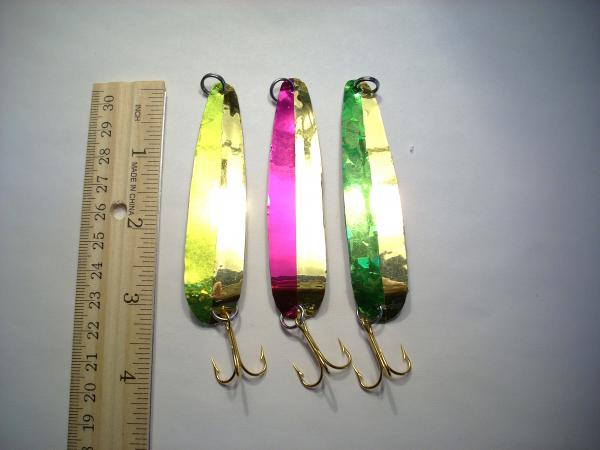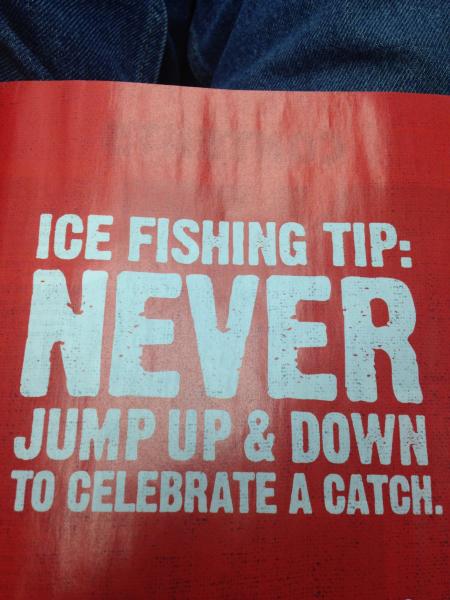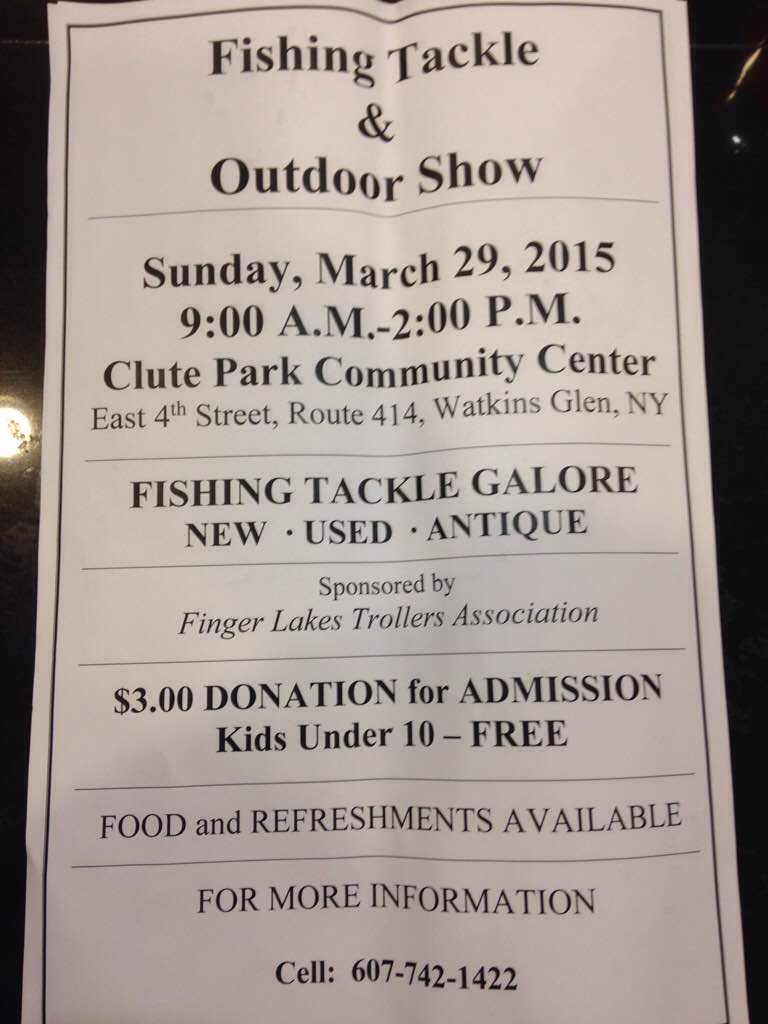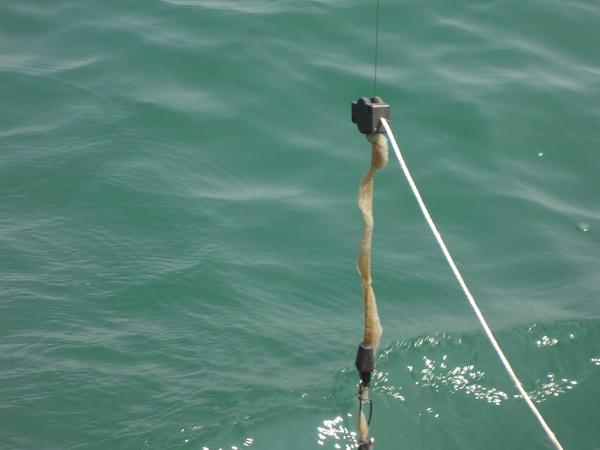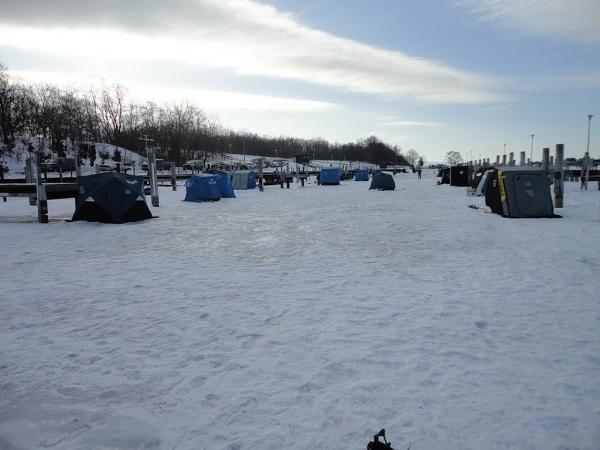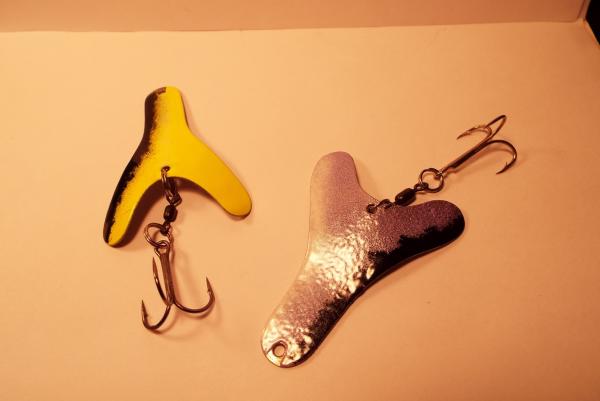-
Posts
13,858 -
Joined
-
Last visited
Content Type
Profiles
Forums
Events
Gallery
Store
Everything posted by Sk8man
-
The spoon in question is a Sutton #28 silver finish flutter weight for pulling copper. You will notice in the pic the Sutton 88 is on the left the 28 is in the middle and the 35 is on the right. Notice the difference in shape of the 35 especially....similar in shape to the 28 but not exact. It is possible that the spoon was "re-hooked" which could explain the screw and nut but on the other hand many of my Sutton's have the screw and nut while others have the common rivet
-
You may want to reconsider running 12 lb weights off the minis they will be struggling and extremely slow. I think 10 lb is the max on the older motors anyway.
-
-
-
It will stay on as long as it is still in the water. It shuts off after a set amount of time after it is retrieved and is out of the water. The water keeps it active and the water pressure changes activates the depth capability.
-
I've had one for a couple of years and if used properly it is pretty neat. I don't presently have a Fish hawk 4 or 4D so I attach it to one of my riggers when I am at about 100 ft water depth and send it down and bring it back up and record the specific temps at 5 ft intervals on a chart with a grease pencil down to 100 ft (although it goes deeper) and look for the thermocline (greatest variation in temps) and then set my lines accordingly. I do know that the thermocline changes throughout the lake to some degree so it is not a sure fire instrument when used that way but much better than nothing. I also have used it to determine just how deep my coppers, leadcores and dipseys are running and it works fine. Yes it does have an auto shut off to save on the the battery but only when it is out of water once it hits the water it is fine and I've NEVER had a problem with it used in that manner. Oh and I should also mention that it served as a "back up" when my buddy's X4 probe dropped to the bottom of Lake O....I think he is still in Florida recovering from that one
-
-
-
It is unfortunate indeed that the Sutton spoons aren't being produced right now and although I don't have an easy answer as far as a "substitute" I will say that there isn't anything magical about the Sutton 44 but they have always been popular. I've used nearly all of the Sutton's over the years and at one point had nearly 300 of them of varying size,weight, and type (some for copper jerking etc.). On the Finger Lakes these spoons have been very effective for many many years...possibly not so much on Lake O because of the higher general trolling speeds frequently for salmon and steelies. The larger the Sutton and the wider in general the less tolerant of higher speeds they seem to be. The Sutton 44 is sort of a middle smaller sized spoon (compared with something like the 88 for example) and as such it approximately represents the size of a medium stage alewive. This is possibly one factor in its success because there will be medium sized alewives present for quite a bit of the life cycle during the boating season. A most important factor regarding any of the Sutton spoons is that they are silver plated on a brass blank and are quite thin in thickness making them appear to"flutter" in the water at depth and because of the silver plating they can be seen at greater distances than say chrome plated spoons. Suttons also have shallow "cups" at the rear that don't really dig down in the water like some spoons. These are the critical attributes that you need to look for in anything considered as a "substitute". I have also done as well over the years with similar sized Sutton's other than the 44 such as the 22 (a little wider), 31 (a little narrower), (the irregular 29),21(little wider). Some of the smaller ones such as the 8, 9 and even the real small 6 work very well immitating the immature alewife and can tolerate greater speed variations than the other sizes of spoons. They work particularly well on rainbows, landlocks and browns on leadcore or copper. What I'm leading up to here is the fact that often these other very effective Sutton spoon are often overlooked in favor of the 44 and they may be present at yard sales, tackle flea markets etc. One of the things about the finish of Suttons is that the silver finish is very thin and easily tarnishes and water spots especially with extended hard use so when they appear in these "sale" situations they are often in poor shape appearance wise but they still function fine. Those of mine that have tarnished over the years I have used thin prism tape (often silver) on to cover the blemishes that don't respond to silver polish with a soft cloth. Sometimes it is difficult to "bring the spoons back" as they have had a clear varnish like substance applied over the silver to "protect" the finish. Another thing to consider with Suttons is the quality of the hooks that come with them....they are not very strong or durable and I have always changed those trebles for hardened single siwash salmon hooks of appropriate size to the spoon with the exception of the tiniest 6's and 8's which I am reluctant to tamper with because of weight difference issues affecting the action. I never mess with the soldered rings on the rear of the spoons as they are more solid than split rings I merely sacrifice the trebles and then replace them on the solid ring with singlel It is often noted on here that the Suttons are to be used for slower speeds and this is generally true especially for the larger lighter flutter spoon versions (not so much with the smaller spoons). They are relatively easy to tune because of their thinness and this can often make them run better at speed (careful bending of them). Suttons also come in medium and heavier weight spoons in many of the same numbered versions as well as other sizes and shapes. The common spoons are the plain silver, silver with brass under side, plain brass, and hammered finish versions of these (my favorites) as well as silver with copper undersides (primarily heavier weight spoons) which seem to be very attractive to brown trout in the Fingers. I guess the long and short of it is if you can't find substitutes look around for overlooked "gems" used ones....it is primarily the action of them that you are really after.
-
Dealing with sensitive bites: When fishing for panfish and perch the standard short light weight jigging rods may not be sensitive enough to detect very light bites or "mouthing" by fish. When weather conditions are windy and or it is snowing it is hard to detect line movement that might be involved in this fish behavior too. As an aide to assist in the detection of these very subtle behaviors it can be beneficial to use a wire extension to the tip of the rod such as a "spring bobber" or a homemade device made from a single strand of stainless steel wire gauged from .022 to .026 inches (stiff enough but sensitive and flexible enough for the job) in diameter with a highly visible plastic or glass bead affixed to the tip with a rounded section that your line runs through extending from the tip of the rod itself. This springy flexible wire is strong but highly sensitive to movement or vibration of the line as a fish at the other end does something to or with your jig. I have watched even large fish such as landlocked salmon and bass as well as perch "suck" the bait into their mouth without moving the line or rod tip and if not watching them through the hole you'd never even know they were there. There are various inexpensive versions of these devices for sale but for many years I have made my own. They only take a few minutes to make and are inexpensive and you can choose your own colors,shapes and sizes and materials for visibility beads as well as adjust the length of the wire to your own preference. In the second pic the wire at the right is the wrongly bent wire and bead. Make your bend at the edge of the bead toward you at a sharp right angle NOT at the loop end. leave a tiny end of the wire past the hole in the bead so that you can bend it with needle nose pliers so that it holds the loop in place. It should then only protrude about a 1/16 inch past the outer circumference of the bead to hold it in place. I use hot glue to attach the non bead end of the wire through the tip of the rod so it extends to the desired length but regular glue can be used as well.You have to be very careful with the hot glue approach not to weaken the rod itself as it is pretty thin material so I drip it on rather than placing the gun tip right on the rod itself. You want to make the loop at the end a generous size so that it helps keep ice buildup off the tip of the rod and it is easier to clear as well.
-
Excellent suggestion...I camped there for years...great place on the St. Lawrence rather than the lake itself but a nice big camp ground and many places close by with smallies, panfish, and pike fishing near Eel Bay which is nearby. Just have to remain aware of where you are out there because the US/Canada line is fairly close by too .
-
I think they have changed motors a few times starting in the early nineties (for the old mags)? I have run the original Mag 10's from the mid eighties when I bought them and they have thousands of hours on them but I have never run any weight on them over 10 lbs either which was the max. weight recommended for them. They still run just as well as the day I bought them and they don't have auto stop either I have adjusted the drag on the downriggers so that if I am busy or forget (more likely ) to get to them they just stay at the top position until I get to them. I am not a charter guy or anything so the speed factor isn't all that relevant to me I actually like the fact that the downriggers aren't high speed and the fact is that although there is "blowback" it is something I am used to adjusting for in conjunction with the display on my depth finder and some blowback will be present in most situations anyway. I'll probably incur a lot of flack for my next comment but I think a lot of the problems encountered with the newer downriggers relate to the high speed/high weight ratio which creates tremendous torque on the motor mechanisms under real time usage and the variety of weight shapes may influence this as well (e.g. some having much more resistance in the water). I'm not a mechanical engineer or anything so just an opinion to throw out there....I also wonder about how much specific time Cannon devoted to physically testing these new ones out in real life circumstances (e.g. currents, boat bouncing around etc.) I also think I would be more suspicious of the electrical /motherboard aspects. The competition is keen so they'd better get their act together as Mike suggests in the next post.
-
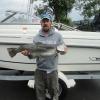
Braid and dipsy divers
Sk8man replied to fish-on's topic in Questions About Trout & Salmon Trolling?
Just a little side note on the flea issue - A lot of stock is being placed on line DIAMETER or even texture/material but when the fleas are really bad in an area of the lake not just east/west etc. but at certain depths in the water column they will adhere to nearly anything regardless of diameter especially things vertical in the water. The 150 or 200 lb downrigger cable in my previous post above is a good example of this. Most folks get only intermittent variations of concentrations for a variety of reasons. What I'm saying is don't be fooled into thinking that just because something is a given diameter or texture and may work when the fleas are at some level doesn't mean that it will always work that way. I do believe though that they are easier to remove from wire than braid in thick concentrations after experiencing them in both situations. -
fathobbit you certainly have the right idea....experimentation is what it is all about and thinking out of the box - can make all the difference in the world on those tough days when the bite is off especially. Trolling around with the same old approaches with the HOPE that something will happen (which we all have done) is a "missed opportunity". Taking charge and making something happen is the way to go.
-
-

My first & second attempt at powder paint on lures
Sk8man replied to Patriot's topic in Open Lake Discussion
-
A couple things come to mind immediately about the driving on the trailer suggestion. With a roller or part roller trailer trailer it is possible to do damage to the hull (make indentations in the bottom from pressure) and many launch ramps prohibit "power loading". Jeff - I was sort of joking regarding that winch....truly a lot of money...especially when instead you can develop Popeye arms with the manual type for less money
-
The new "improved" unit has the same name designation and some of the features have been described above in this post.
-
-
I don't think the new unit has been released yet for retail sale
-

Oak Orchard First Day
Sk8man replied to Draggin The Line's topic in New York Fishing Reports - Lake Ontario (South Shore)
good one Warren! We are a rare bunch aren't we? -
This season....probably August if we're lucky As soon as the ice is safely out. Just a word of caution (based on personal experience) Always avoid going out there when you still have ice behind you in a canal or channel that has not come out into the lake yet. You can leave the launch ramp fine only to return and realize that the ice floes have broken loose upstream and blocked your return to the launch and you may find yourself crunching your way through the ice floes (if you are luck enough to find some that won't sink your boat ...right Admiral Byrd?)
-
Jeff- This may be what you are looking for...Has manual crank capability as well...not cheap but.....you have a beautiful boat,,,,it deserves the very best http://www.wholesalemarine.com/powerwinch-12v-marine-boat-trailer-winch-915-9500-lb.html?utm_medium=cse&utm_source=bing
-


